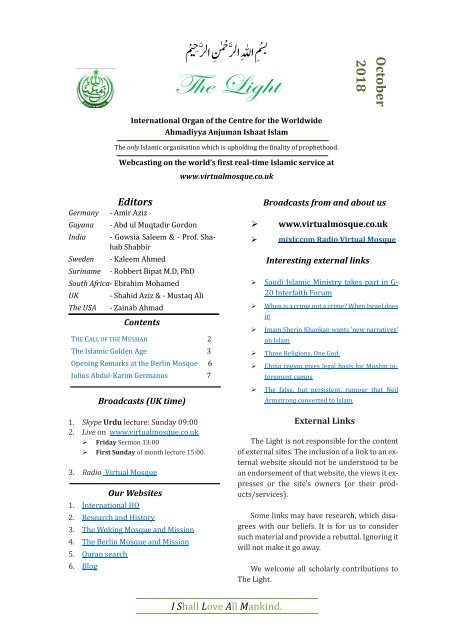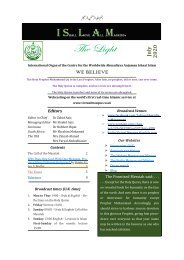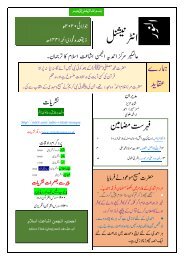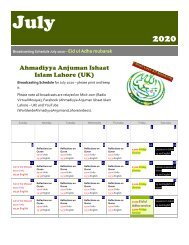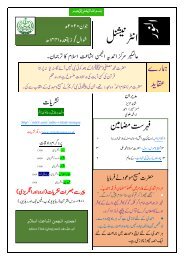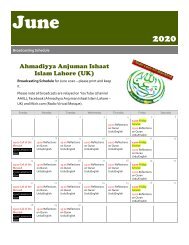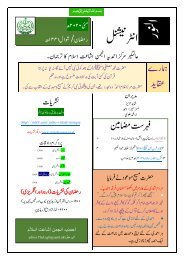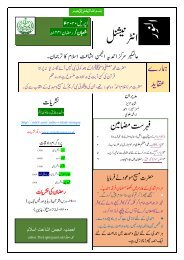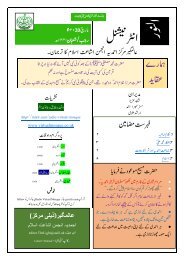The Light 2018 10 October
Representing the Lahore-Ahmadiyya Movement's interpretation of Islam as a peaceful, inclusive, rational, scientific and loving religion.
Representing the Lahore-Ahmadiyya Movement's interpretation of Islam as a peaceful, inclusive, rational, scientific and loving religion.
Create successful ePaper yourself
Turn your PDF publications into a flip-book with our unique Google optimized e-Paper software.
ِ ی م الرَّحم<br />
ن<br />
ِ<br />
سب اہللِ الرَّْحم ٰ<br />
ْ م ِ<br />
<strong>The</strong> <strong>Light</strong><br />
International Organ of the Centre for the Worldwide<br />
Ahmadiyya Anjuman Ishaat Islam<br />
<strong>2018</strong><br />
April<br />
2016<br />
<strong>October</strong><br />
<strong>The</strong> only Islamic organisation which is upholding the finality of prophethood.<br />
Webcasting on the world’s first real-time Islamic service at<br />
www.virtualmosque.co.uk<br />
Germany<br />
Guyana<br />
India<br />
Sweden<br />
Suriname<br />
Editors<br />
- Amir Aziz<br />
- Abd ul Muqtadir Gordon<br />
- Gowsia Saleem & - Prof. Shahab<br />
Shabbir<br />
- Kaleem Ahmed<br />
- Robbert Bipat M.D, PhD<br />
South Africa- Ebrahim Mohamed<br />
UK<br />
<strong>The</strong> USA<br />
- Shahid Aziz & - Mustaq Ali<br />
- Zainab Ahmad<br />
Contents<br />
THE CALL OF THE MESSIAH 2<br />
<strong>The</strong> Islamic Golden Age 3<br />
Opening Remarks at the Berlin Mosque 6<br />
Julius Abdul-Karim Germanus 7<br />
Broadcasts (UK time)<br />
1. Skype Urdu lecture: Sunday 09:00<br />
2. Live on www.virtualmosque.co.uk<br />
‣ Friday Sermon 13:00<br />
‣ First Sunday of month lecture 15:00.<br />
3. Radio Virtual Mosque<br />
Our Websites<br />
1. International HQ<br />
2. Research and History<br />
3. <strong>The</strong> Woking Mosque and Mission<br />
4. <strong>The</strong> Berlin Mosque and Mission<br />
5. Quran search<br />
6. Blog<br />
Broadcasts from and about us<br />
‣ www.virtualmosque.co.uk<br />
‣ mixlr.com Radio Virtual Mosque<br />
Interesting external links<br />
‣ Saudi Islamic Ministry takes part in G-<br />
20 Interfaith Forum<br />
‣ When is a crime not a crime? When Israel does<br />
it!<br />
‣ Imam Sherin Khankan wants 'new narratives'<br />
on Islam<br />
‣ Three Religions, One God.<br />
‣ China region gives legal basis for Muslim internment<br />
camps<br />
‣ <strong>The</strong> false, but persistent, rumour that Neil<br />
Armstrong converted to Islam<br />
External Links<br />
<strong>The</strong> <strong>Light</strong> is not responsible for the content<br />
of external sites. <strong>The</strong> inclusion of a link to an external<br />
website should not be understood to be<br />
an endorsement of that website, the views it expresses<br />
or the site's owners (or their products/services).<br />
Some links may have research, which disagrees<br />
with our beliefs. It is for us to consider<br />
such material and provide a rebuttal. Ignoring it<br />
will not make it go away.<br />
We welcome all scholarly contributions to<br />
<strong>The</strong> <strong>Light</strong>.<br />
I Shall Love All Mankind.
<strong>October</strong> <strong>2018</strong> <strong>The</strong><br />
<strong>Light</strong> 2<br />
<strong>The</strong> Call of the<br />
Messiah<br />
by Hazrat Mirza Ghulam<br />
Ahmad<br />
<strong>The</strong> Promised Messiah and Mahdi<br />
(Editor’s note: Any quotations from the Quran<br />
are translated from the author’s explanations<br />
and are not literal translations of the verse<br />
quoted. This extract is from the English translation<br />
of a lecture he delivered in 1904 in Lahore,<br />
now in Pakistan, taken from the Lahore Ahmadiyya<br />
publication ‘Essence of Islam’, p. 62 – 65)<br />
Signs of the Latter Age<br />
<strong>The</strong> Holy Quran has mentioned many other<br />
signs of the last ages when all people would<br />
gathered around one religion. For example, the<br />
rivers would be commonly split into canals, the<br />
earth would bring out its hidden treasures of<br />
minerals, inventions and sciences would bring<br />
such means into existence which would cause<br />
books to be multiplied in large numbers, a ride<br />
would be invented rendering camels useless<br />
and facilitate human travel, means of correspondence<br />
and the mixing together of different<br />
people would become easy, and that the sun and<br />
the moon would eclipse on specified dates in<br />
the month of Ramadaan. All these signs of the<br />
mercy of God would be followed by another<br />
which is indicative of the wrath of heaven, i.e.<br />
the raging of a destructive plague which would<br />
affect every town and village utterly laying<br />
waste some and leaving others in a partially<br />
desolate condition. God would then be in great<br />
wrath because the signs which He manifested at<br />
the hands of His Messenger were belied, and the<br />
Apostle whom He had sent was rejected and<br />
called an imposter.<br />
All the signs enumerated above, which the<br />
Holy Quran has described as the signs of the appearance<br />
of the Promised one, have been fulfilled<br />
in this age. Thus, there is a clear path for<br />
anyone who exercises his judgment and understanding<br />
for my acceptance, because all the<br />
signs appointed for the appearance of the<br />
Promised Messiah have been manifested by God<br />
for me. Besides the signs mentioned above, the<br />
Holy Quran fixes the time of the appearance of<br />
the Promised Messiah in another manner too. In<br />
I Shall Love All Mankind.<br />
it we are told that one day with God is equivalent<br />
to a thousand years as is indicated in the<br />
verse: “And surely a day with your Lord is like a<br />
thousand years as you count” (22:47). <strong>The</strong>refore,<br />
the seven days mentioned in the Holy<br />
Quran indicated seven thousand years which<br />
represent the present age from Adam to the end<br />
spoken of in the holy books of God. I do not<br />
mean to say that seven thousand years is the<br />
whole time from the beginning to the end of the<br />
world, for from the Holy Quran it appears that<br />
the world existed before the Adam spoken of in<br />
the Holy Book. Of course, we cannot say who the<br />
people were that lived upon earth then because<br />
we have not details in our hand. But it appears<br />
that one cycle of this world lasts for seven thousand<br />
years and hence also the seven days, each<br />
day standing for a thousand years. We cannot<br />
say through how many such cycles the world<br />
has passed up to this time, and how many Adams<br />
have passed before our own Adam. As God<br />
has ever been the Creator, therefore we believe<br />
that His creation must have existed always in<br />
some form or another though it is difficult for<br />
us to specify the particular form. Here too the<br />
Christian faith has erred, for the Christians believe<br />
that the world was created and heaven and<br />
earth made only six thousand years ago, and<br />
that before that time the creating power of God<br />
had for ever remained unemployed. I do not<br />
think any sensible person can subscribe to such<br />
a belief which is absurd on the face of it. <strong>The</strong><br />
Holy Quran on the other hand teaches us doctrines<br />
whose truth can never be questioned. It<br />
teaches us that God has always been a creator<br />
and will for ever be a creator, and if He will he<br />
can destroy heavens and earth and make them<br />
anew millions of times. He has told us that from<br />
the Adam who is our ancestor to the end of this<br />
cycle, there is a period of seven thousand year,<br />
which are as seven days with God. <strong>The</strong> Holy<br />
Prophet Muhammad (s) appeared in the fifth<br />
thousand after Adam or in the fifth day of this<br />
cycle. This is indicated in the chapter entitled<br />
Asr (afternoon) the letters of which, according<br />
to the mode of reckoning numbers from letters,<br />
represent the number of years which had<br />
elapsed from Adam to the time of the revelation<br />
of that chapter to the Holy Prophet. According<br />
to this calculation six thousand years have now
<strong>October</strong> <strong>2018</strong> <strong>The</strong><br />
<strong>Light</strong> 3<br />
elapsed from Adam, and a period of one thousand<br />
years more would complete this cycle.<br />
(Return to contents)<br />
Islamic Golden Age<br />
A Brief Review of Contributions to Today’s<br />
World.<br />
by Dr. Ejaz Naqvi, MD<br />
http://www.patheos.com/blogs/askamuslim/<strong>2018</strong>/05/islamic-golden-age-a-brief-review-of-contributions-to-todays-world/<br />
My last article was a brief overview of the<br />
Islamic golden age. This article’s focus is on<br />
some of the important contributions from this<br />
era, realizing a full review would require writing<br />
a multi- volume book. My initial thought was<br />
Text of an early Islamic treatise on medicine<br />
in the Turkish Science Museum Istanbul.<br />
to write about individual scholars but upon further<br />
pondering, I decided to sort them under<br />
specific fields, although I will mention a few notables<br />
here.<br />
Since publishing the last article, I have had<br />
quite a bit of feedback, ranging from “Let’s not<br />
dwell in the glory of the past given the ‘plight of<br />
the Muslims’ today”, on one hand to the other<br />
extreme where folks tend to get stuck in the<br />
past without any references to its implication<br />
on today’s world.<br />
I would like to strike a balance. Healthy nations<br />
and communities do not forget their past.<br />
We have not forgotten the contributions by Einstein,<br />
Isaac Newton, Galileo, Copernicus from<br />
the last few hundred years, and Galen, Aristotle<br />
and Socrates from over 2 thousand years ago.<br />
We cannot forget those who lived in between<br />
I Shall Love All Mankind.<br />
these two eras during the Islamic golden age.<br />
Muslims should be proud of their glorious past,<br />
and highlight the accomplishments as a source<br />
of inspiration to bring about a change in our<br />
lives today.<br />
We need to learn what kind of critical thinking<br />
and attitude led to the golden age, and what<br />
caused its fall. Only then this conversation will<br />
be meaningful and relevant.<br />
Medicine and hospitals<br />
Hospitals and Teaching: Ahmad Ibn Tulun<br />
hospital in Cairo, built in the early 870s, is considered<br />
the first full-fledged Islamic hospital,<br />
where patients were treated free of charge. Like<br />
the modern hospitals, patients would give their<br />
street clothes and valuables to the hospital and<br />
put their hospital gowns on. <strong>The</strong> hospital had a<br />
psychiatric ward and a rich library.<br />
Baghdadi hospital was built about a hundred<br />
years later with 25 physicians. Subsequently<br />
more, and larger hospitals were built<br />
throughout the empire ranging from Nuri hospital<br />
in Damascus, Al Mansuri hospital in Cairo<br />
to Andalusia.<br />
<strong>The</strong>se hospitals were also teaching hospitals<br />
where students were taught by the physicians<br />
as they tended to the ill. Teaching was<br />
done individually, as well as in groups, lectures<br />
given in a large hall at the hospital and there<br />
were questions and answers sessions along<br />
with ‘teaching rounds’ whereby the staff physician<br />
would do history and examination of the<br />
patient accompanied by students- much the<br />
same then as it is done in teaching hospitals<br />
now. <strong>The</strong> hospitals in Andalusia inspired the Europeans<br />
to build their own system.<br />
<strong>The</strong> health care delivery was a ‘single payer’<br />
system, where the payer was the Islamic government.<br />
<strong>The</strong> admission to the hospital, the surgeries,<br />
the vaccinations and dispensing of the<br />
medicines were all done free of cost to the patients-<br />
a system the current British national<br />
health system closely follows. (Are you paying<br />
attention, Bernie Sanders?). <strong>The</strong>re was another<br />
important source of funding that supported the<br />
running of the hospitals.<br />
U.S. National Library of Medicine section on<br />
Islamic Culture and Medical arts states: “All the
<strong>October</strong> <strong>2018</strong> <strong>The</strong><br />
<strong>Light</strong> 4<br />
A book on Optics in the Science Museum Istanbul.<br />
hospitals in Islamic lands were financed from<br />
the revenues of pious bequests called waqfs.<br />
Wealthy men, and especially rulers, donated<br />
property as endowments, whose revenue went<br />
toward building and maintaining the institution.<br />
<strong>The</strong> property could consist of shops, mills,<br />
caravanserais, or even entire villages. <strong>The</strong> income<br />
from an endowment would pay for the<br />
maintenance and running costs of the hospital,<br />
and sometimes would supply a small stipend to<br />
the patient upon dismissal. Part of the state<br />
budget also went toward the maintenance of a<br />
hospital. <strong>The</strong> services of the hospital were to be<br />
free, though individual physicians might charge<br />
fees.”<br />
Pulmonary Circulation<br />
Galen, a Greek physician from the 2nd century<br />
and a giant in his own right, described the<br />
circulation to the right side of<br />
the heart. From the right side of<br />
the heart, he postulated, the<br />
blood goes<br />
through tiny<br />
First page<br />
of ibn al<br />
Nafi’s treatise.<br />
pores in the septum<br />
(that separates the right and<br />
the left ventricles). In the 13th<br />
century, Ibn al Nafis explained<br />
the pulmonary circulation correctly,<br />
describing that the blood<br />
goes from the right side of the<br />
heart to the lungs for oxygenation, then to the<br />
left side of the heart.<br />
Ophthalmology<br />
Physicians from this era were performing<br />
various eye surgeries and writing text books. Al-<br />
Mawsili (also spelled Al Mosouli), the author of<br />
I Shall Love All Mankind.<br />
the Book of Choices in the Treatment of Eye diseases,<br />
designed a hollow needle he inserted into<br />
the anterior chamber of the eye to remove cataract<br />
by suction- a procedure that is still in use<br />
and curing poor eyesight and preventing blindness<br />
in many others.<br />
Optics and Vision<br />
Ancient Greek philosophers and scientists<br />
believed in two theories about how we see objects.<br />
<strong>The</strong> first postulated that rays come out of<br />
our eyes and are cut off by objects. <strong>The</strong> second<br />
postulated, without any evidence that we see<br />
because something (objects image) enters our<br />
eyes, but without the support of experimentation.<br />
Al-Kindi, a 9th century polymath, philosopher,<br />
physician and an optician stated that our<br />
visual cone is not formed of discrete rays but rather<br />
as a volume and in three dimensions of<br />
continuous radiations. He discussed the effects<br />
of distance and angle on the sight (e.g. how a circle<br />
on its side appears linear) and optical illusions.<br />
16th century Italian physician and mathematician<br />
Geronimo Cardano said Al Kindi was<br />
“one of the twelve giant minds of history”. [1]<br />
Al- Haytham, known as Alhazen in the west,<br />
a <strong>10</strong>th century polymath, mathematician, physician<br />
and a chemist, is considered the father of<br />
Optics and the first to use experimental evidence<br />
to confirm theories. His most influential<br />
work was his book, Kitab Al Manazir, or <strong>The</strong><br />
Book of Optics (known as his Magnum Opus),<br />
had laid the foundation for the science of Optics.<br />
He was the first to explain that vision occurs<br />
when light bounces on an object and then is directed<br />
to one’s eyes.<br />
Until this time physics had been more like<br />
philosophy, without experiment. He was the<br />
first to require experimental evidence to support<br />
a hypothesis or a theory. He is thus considered<br />
the father of scientific methods. George<br />
Sarton, a 20th century science historian in his<br />
book History of Science stated, He, Ibn Haytham,<br />
was the greatest Muslim physicist and<br />
student of optics of all times. Whether it be in<br />
England or far away Persia, all drank from the<br />
same fountain. He exerted a great influence on<br />
European thought from Bacon to Kepler.”[2]<br />
Al- Razi (Rhazes)
<strong>October</strong> <strong>2018</strong> <strong>The</strong><br />
<strong>Light</strong> 5<br />
Considered one of the brightest physicians,<br />
he was a philosopher, alchemist and musician.<br />
His most notable writing is <strong>The</strong> Comprehensive<br />
Book on Medicine (Kitab al-Hawi fi al-tibb) - a<br />
large notebook with extracts from earlier authors<br />
regarding diseases and therapeutics. In<br />
addition, he recorded clinical cases of his own<br />
experience. <strong>The</strong> material comprising the Hawi<br />
is arranged under headings of different diseases,<br />
with separate sections on pharmacological<br />
topics.<br />
From National Library of Science: “His Comprehensive<br />
Book on Medicine, the Hawi, was<br />
translated into Latin in 1279 under the title<br />
Continens by Faraj ben Salim, a physician of Sicilian-Jewish<br />
origin employed by Charles of Anjou<br />
to translate medical works. Even more influential<br />
in Europe was al-Razi’s Book of Medicine<br />
Dedicated to Mansur, a short general textbook<br />
on medicine in ten chapters which he had dedicated<br />
in 903 (290 H) to the Samanid prince Abu<br />
Salih al-Mansur ibn Ishaq, governor of Rayy. <strong>The</strong><br />
treatise was translated into Latin in Toledo by<br />
Gerard of Cremona (d. 1187) and was known as<br />
Liber ad Almansoris. It became one of the most<br />
widely read medieval medical manuals in Europe,<br />
and the ninth chapter, on therapeutics,<br />
frequently circulated by itself under the title Liber<br />
nonus ad Almansorem. In the Renaissance,<br />
many editions of it were printed with commentaries<br />
by the prominent physicians of the day,<br />
such as Andreas Vesalius.”<br />
Ibn Sina (Avicenna 980-<strong>10</strong>37)<br />
Probably the most well-known from the era,<br />
he was born in Afshana, Bukhara (currently Uzbekistan<br />
and lived in Persia in his early life. He<br />
was a polymath, a physician, a theologian, astronomer<br />
and a mathematician-among others.<br />
He was a prolific writer and is believed to have<br />
Early Islamic surgical instruments – Science Museum Istanbul.<br />
I Shall Love All Mankind.<br />
written over 450 books, of which about 250<br />
have survived. His most influential book is Al-<br />
Qanun fi al-Tibb, or Code of Laws in medicine,<br />
commonly known as the Canon of Medicine. It is<br />
a 5-volume encyclopaedia that covers the principles<br />
of Medicine, diseases of various parts of<br />
the body, general diseases and fractures. It remained<br />
in use in medical schools in Europe until<br />
the 17th century.<br />
Here is a small excerpt from the National Library<br />
of Medicine.<br />
<strong>The</strong> Canon of Medicine was widely read by<br />
Europeans in the Latin translation of Gerard of<br />
Cremona made in the 12th century. So great was<br />
the interest in this mammoth medical textbook<br />
that late in the 15th century Girolamo Ramusio<br />
attempted to improve upon Gerard of Cremona’s<br />
Latin translation by comparing it with<br />
an Arabic manuscript, and in 1527 a new Latin<br />
version was published that had been made by<br />
Andrea Alpago (d. 1522), who had resided in<br />
Damascus for thirty years as a physician in the<br />
service of the Venetian Republic and had used<br />
his fluency in Arabic not only to translate it but<br />
also to append an Arabic-Latin glossary of<br />
terms. Between 1500 and 1674 some sixty editions<br />
of part or all of the Canon were published<br />
in Europe, mostly intended for use in university<br />
medical training.<br />
When he died in <strong>10</strong>37 he was known as one<br />
of the greatest philosophers of Islam, and in<br />
medicine he was so highly regarded that he was<br />
compared to Galen.<br />
In honour of his immense contributions, especially<br />
in Medicine and Philosophy, UNESCO<br />
celebrated the thousand-year anniversary of his<br />
birth in 1980.<br />
Al-Zahrawi (936-<strong>10</strong>13)<br />
Born in Cordoba, Andalusia,<br />
he is probably the most famous<br />
surgeon from the medieval and<br />
Middle ages. He is best known<br />
for revolutionizing surgical procedures and surgical<br />
instruments. His principal work is the<br />
Kitab al-Tasrif, a thirty-volume encyclopaedia of<br />
medical practices, covering Surgery, Medicine,<br />
Pharmacology, pathology, Ophthalmology and<br />
Obstetrics, among others. <strong>The</strong> surgery volume
<strong>October</strong> <strong>2018</strong> <strong>The</strong><br />
<strong>Light</strong> 6<br />
in this encyclopaedia was later translated into<br />
Latin where it received popularity and became<br />
the standard textbook in Europe for the next<br />
500 years.<br />
Al-Zahrawi’s pioneering contributions to<br />
the field of surgical procedures and instruments<br />
had an enormous impact in the East and West<br />
well into the modern period, where some of his<br />
discoveries are still applied in medicine to this<br />
day. [3]<br />
His contributions include:<br />
First physician to describe abdominal pregnancy<br />
(a type of ectopic pregnancy-meaning the<br />
foetus growing in sites other than the usual<br />
uterus implantation).<br />
First physician to describe the hereditary<br />
nature of haemophilia.<br />
On Surgery and Instrumentation is the last<br />
volume of his encyclopaedia, Al Tasrif, which details<br />
surgical procedures, how to perform them,<br />
and contains the pictures of the surgical instruments<br />
that are still in use. He introduced numerous<br />
surgical procedure for trauma, neurosurgery,<br />
obstetrics and other areas, and over<br />
200 surgical instruments. He introduced catgut<br />
for internal stitching, which is still used as a<br />
self-dissolving form of suturing. He revolutionized<br />
surgical procedures in being the first to<br />
perform procedures such as using bone replacement<br />
for lost teeth, surgical procedure for<br />
sagging breasts, using cotton to control bleeding,<br />
performing a tracheostomy and other innovative<br />
procedures for renal stones. He described<br />
how to remove a dead foetus by using<br />
forceps, and designed the vaginal specula. <strong>The</strong><br />
list goes on but I hope you got the picture.<br />
Celebrating Completion of Repair<br />
Works at our Historic Berlin<br />
Mosque<br />
Opening Remarks<br />
By Guenther Paetz<br />
Director of Deutsche Stiftung<br />
Denkmalschutz Kuratorium Berlin<br />
(This speech was delivered at a presentation<br />
on 8 th September <strong>2018</strong> during the function<br />
held to commemorate the completion of the external<br />
repair work to the Mosque and the<br />
imam’s house. – Editor)<br />
Dear Madams and Sirs, Dear Mr. President,<br />
Dear Imam, Dear Muhammad,<br />
As the oldest preserved Islamic mosque in<br />
Germany, the Wilmersdorf Mosque has a high<br />
historical, urban and architectural value. <strong>The</strong><br />
mosque is regarded as an outstanding structural<br />
testimony to the cosmopolitan and multicultural<br />
development trends in the 1920s and<br />
embodies an important identification object for<br />
the urban development area southwest of the<br />
Fehrbelliner Platz.<br />
It takes a place like the Wilmersdorf<br />
Mosque, under whose dome we are standing,<br />
for the dialogue of an individual with God and<br />
Allah. It also requires a place where lively, openminded<br />
and inquisitive people of different religions<br />
and backgrounds can engage in dialogue<br />
on how we shape and sustain the future of our<br />
world through the experiences of all, positively<br />
and progressively. Such a place should be the<br />
“House of the Imam” right next door also in the<br />
future.<br />
(Return to contents)<br />
<strong>The</strong> Mosque after completion of external repairs.<br />
I Shall Love All Mankind.<br />
Hazrat Ameer, Imam Amir Aziz and the Head of Archive<br />
Department Germany, signing a contract to preserve<br />
the Berlin Mosque archive.
<strong>October</strong> <strong>2018</strong> <strong>The</strong><br />
<strong>Light</strong> 7<br />
<strong>The</strong>refore, for the funding year <strong>2018</strong>, the<br />
DSD uses the funds of the German Class Lottery<br />
Berlin, and in particular the Glu cksspirale, to<br />
pay a financial donation of 25,000 euros for the<br />
renovation of the “House of the Imam”, in detail<br />
for window repair / facade paint/ carpentry<br />
work / repair of concrete cornice / other concrete<br />
work).<br />
With our donation we want to support the<br />
architectural future of the Wilmersdorf Mosque<br />
as the home of the Berlin Ahmadiyya community,<br />
as we already did for over 20 years in a row.<br />
I am very proud to have found friends here<br />
in the Wilmersdorf Mosque.<br />
I am grateful that the leadership of the Ahmadiyya<br />
community in Pakistan, Imam Amir<br />
Aziz and the members of the community are<br />
very conscious of their importance and responsibilities.<br />
In the sense of their own community,<br />
as an intellectual dialogue for the defence of<br />
free thought, as a presence and part of religious<br />
diversity in a cosmopolitan Berlin on the basis<br />
of our constitution, the Ahmadiyya community<br />
lives and practices its own identity every single<br />
day. That´s a good sign to the world.<br />
I wish the Wilmersdorf Mosque and your<br />
community the continuation of the positive development,<br />
a future in peace and Allah's blessing!<br />
(Return to contents)<br />
Unknown sources for the<br />
examination of oeuvre of<br />
Hajji Julius Abdul-Karim<br />
Germanus, Hungarian<br />
Muslim Orientalist Professor<br />
(1884-1979)<br />
Zsolt Udvarvölgyi, PhD<br />
Historian, Sociologist, Associate Professor<br />
Budapest, Hungary<br />
contributed by Dr Zahid Aziz<br />
Brief resume:<br />
Hajji Julius Abdul-Karim Germanus, Hungarian<br />
Muslim Orientalist Professor (1884-<br />
1979) was an outstanding scholar and popular<br />
figure in Hungary from the turn of the century<br />
until late seventies. He was an Arabist, teacher,<br />
writer, traveler, literary historian as well as MP<br />
in Hungary and member of many academies<br />
abroad. In our article - publishing three unknown<br />
sources of his legacy – we would like to<br />
contribute to a better and more objective judgement<br />
of his oeuvre.<br />
A unique career<br />
As Yasser Hejazi 1 wrote in his article, 2 “the<br />
journey of Abdul-Karim Germanus (formerly<br />
known as Julius Germanus) to Islam transformed<br />
his life forever. He once described his<br />
conversion as his ‘moment of awakening’. Germanus<br />
was a university professor in Hungary<br />
who spent half of his life defending Islam and<br />
the Arabic language. After having freed himself<br />
from the troubles of youth and the oppression<br />
of traditions, he became attracted to Islam.”<br />
Germanus was born in Budapest, on 6 November<br />
1884 into a Hungarian Jewish family. In<br />
the summer of 1902 he travelled to Bosnia-Hercegovina,<br />
where he has gained his first experience<br />
on Muslim culture. Immediately after enrolling<br />
in the University of Budapest, he decided<br />
to specialize in the Turkish language. So he traveled<br />
to the University of Constantinople (Istanbul)<br />
in 1903 to study Law in Turkish. In only<br />
two years, he was able to master the Turkish<br />
language and excelled in speaking, reading, and<br />
writing it.<br />
During his time at the University of Constantinople,<br />
he came across an exegesis of the<br />
Quran in Turkish. This marked the beginning of<br />
his transformation and his interest – among<br />
others − in Islam and the Quran. <strong>The</strong> exegesis<br />
enabled him to understand Islam from the original<br />
sources.<br />
Motivated to learn the truth about Islam, he<br />
decided to conduct research in which he compared<br />
what the European scientists were writing<br />
about Islam to what was really written in the<br />
Quran and Sunnah. He also endeavoured to read<br />
Turkish translations of Hadith in order to study<br />
1<br />
Yasser Hejazi is an Egyptian researcher and journalist.<br />
2<br />
Yasser Hejazi: <strong>The</strong> Moment of Awakening A Hungarian Orientalist<br />
Finds Islam. Apr. 12, 2006 in:<br />
I Shall Love All Mankind.<br />
https://archive.islamonline.net/?p=15<strong>10</strong>8 (Accessed on 12 August<br />
<strong>2018</strong>)
<strong>October</strong> <strong>2018</strong> <strong>The</strong><br />
<strong>Light</strong> 8<br />
the sayings of the Prophet Muhammad from authentic<br />
sources. 1<br />
Germanus returned to Hungary from Istanbul<br />
and he decided to study the Arabic language<br />
after he found that Turkish was full of many Arabic<br />
words. He pursued Arabic and soon became<br />
proficient in it then he went on to Persian<br />
(Farsi).<br />
In 1907 he graduated and earned three<br />
master’s degrees in Turkish language and literature<br />
(supervised by Professor A rmin Va m-<br />
be ry), in Arabic language and literature (supervised<br />
by Professor Igna c Goldziher) and in ancient<br />
world history (supervised by Ba lint<br />
Kuzsinszky) as well. Between 1908 and 1911 he<br />
continued his studies as a Hungarian scholar at<br />
the Oriental Department of the British Museum<br />
in London. He was a diligent visitor of libraries<br />
and learned a lot. After returning to Budapest<br />
“Germanus converted to the Calvinist Christian<br />
faith and joined the Hungarian Reformed<br />
Church on 11 <strong>October</strong> 1909.” 2<br />
Professor A rmin (Arminius) Va mbe ry<br />
(1832-1913), at that time a world-famous<br />
Turkologist, traveler, writer and chief adviser of<br />
the British empire on oriental affairs was one of<br />
the mentors of Germanus during his studies and<br />
later. He has exemplary, devotedly helped the<br />
career of the young scientist Germanus. In our<br />
opinion, Va mbe ry’ assistance greatly contributed<br />
to Germanus’ professional development.<br />
With our knowledge, Professor Va mbe ry's original<br />
letters written in English have not been<br />
published yet. We quote an original letter of<br />
Va mbe ry dated on 7 <strong>October</strong> 1908, Budapest in<br />
which he outlines the possibilities of Julius Germanus.<br />
3<br />
“Dear Dr. Germanus,<br />
By strange coincidence your father was just<br />
my guest, when I received your letter, which I<br />
need scarcely say, gave me much pleasure. I am<br />
sorry to see that you cannot fully realise the difficulty<br />
of besetting the position of a young student<br />
and that you are lacking the necessary patience,<br />
always connected with the career of orientalists.<br />
Your future is, as far as I see, more hopeful<br />
than you imagine. At the faculty everybody<br />
speaks of you as of the future professor of Turkish,<br />
but it requires time and you have to give evident<br />
proof of your ability. We must have some<br />
genuine and remarkable publication before we<br />
can propose you for the chair, and I trust we shall<br />
get from your pen some works to lean upon.<br />
You must not think of American or of any<br />
other distant place as of your future field of activity.<br />
Your position in Hungary is safe, and it is<br />
only yesterday that Molnár, whom I met in the<br />
house of a mutual friend, gave me full assurances<br />
on your behalf. If you obtain the lectorship they<br />
will support you with <strong>10</strong>00 Ft a year, until your<br />
appointment becomes feasible.<br />
As to your participation in the journalistic literature,<br />
I do not disapprove of it if you find it<br />
rentable. But is this possible in England under the<br />
present circumstances? Try, but do not stick to it,<br />
for it is barren in the ultimate end. As all events I<br />
send you including a few lines for Dr. Reich.<br />
With the kindest regards and with my best<br />
wishes for your success, I am<br />
Yours very truly,<br />
A. Vámbéry.”<br />
We also quote an original, so-called “fatherly<br />
letter” of Va mbe ry dated on 19 February<br />
1909, Budapest on Germanus’s future. 4<br />
“Dear Dr. Germanus,<br />
I have read with much pleasure your letter<br />
and I am delighted to see that you have entered a<br />
path, which will lead to success, provided that<br />
you preserve. Of course you have got two different<br />
ways before you. <strong>The</strong> one strictly scientific, or<br />
let us say theoretic, which may help you to a professorship,<br />
and the second, which may lay down<br />
the foundation for a future independence. In both<br />
ways you are now on starting point and trusting<br />
to your abilities. I dare say you will triumph in the<br />
end.<br />
My professor has not been as yet filled up and<br />
it is delayed until the proper man is to be found.<br />
Why should you not compete for it? Activity on<br />
the two ways mentioned before, will make it possible<br />
to come out as a champion.<br />
1<br />
Hejazi: Ibid.<br />
2<br />
Mestyan, Adam: Materials for a History of Hungarian Academic<br />
Orientalism: <strong>The</strong> Case of Gyula Germanus. In: Die Welt des<br />
Islams 54 (2014) p. <strong>10</strong>. in: http://www.brill.com/die-welt-desislams<br />
I Shall Love All Mankind.<br />
3<br />
Magyar Földrajzi Múzeum-Érd, Germanus Gyula hagyaték 18.<br />
doboz (Hungarian Geographical Museum, Érd, Legacy of Gyula<br />
Germanus, Box 18.)<br />
4<br />
Ibid.
<strong>October</strong> <strong>2018</strong> <strong>The</strong><br />
<strong>Light</strong> 9<br />
I approve fully on the plan of your book. Very<br />
much depends from your acquaintance with the<br />
respective literature, which is vast one,<br />
Yours sincerely,<br />
Vambery”<br />
Germanus excelled in the study of languages,<br />
and in 1912 he was appointed a lector<br />
of Arabic, Persian, and Turkish as well as Islamic<br />
history at the Hungarian Royal Oriental<br />
Academy in Budapest. He was later appointed<br />
to lecturer and teacher at the Institute of Oriental<br />
Studies of the Faculty of Economic in Budapest.<br />
After working for a short time at the University<br />
of Budapest, the Bengali-Indian poet, winner<br />
of Nobel Prize in Literature (1913)<br />
Rabindranath Tagore (1861-1941), one of India’s<br />
greatest figures, invited Germanus in 1928<br />
to teach as the Head of the Department of Islamic<br />
Studies of Visva-Bharati University in<br />
Santiniketan, Bengal. He stayed with his first<br />
wife, Ro zsa Hajno czy (1892-1944) in India for 3<br />
years (1929-1932) and it was there he publicized<br />
his conversion to Islam in the Great Delhi<br />
Mosque. Henceforth, he was known as Abdul-<br />
Karim. “According to his narration, he became a<br />
Muslim on 19 December 1930, on a Friday, in<br />
the Great Mosque of Delhi. After the khutba, he<br />
gave a short speech, which he began in Arabic,<br />
about having come to India as a seeker of<br />
knowledge, about the place of Islam in the history<br />
of humankind, the decline of the Muslim<br />
peoples, and their possible renaissance. In the<br />
enthusiastic audience a friend hurriedly led him<br />
out, as Germanus remembered, lest the cheering<br />
crowd squeeze him.” 1 In India he met with<br />
Mahatma Gandhi, Jawaharlal Nehru, Subhas<br />
Chandra Bose, Zakir Husain and other leading<br />
figures (politicians, artists, writers, poets).<br />
Germanus’ great desire to learn more about<br />
Islam and Muslims led him to meet one of the<br />
most prominent Muslim poets of the time. He<br />
enjoyed a friendship with the famous Pakistani<br />
Muslim poet, Muhammad Iqbal. <strong>The</strong>y would<br />
have long conversations, delving into important<br />
issues facing Muslims. <strong>The</strong>y also would discuss<br />
the scholarship of Orientalists and the activities<br />
of Christian missionaries. 2<br />
Germanus also formed a strong relationship<br />
with the famous Egyptian writers, Mahmoud<br />
Teymour, Taha Hussein and Naguib Mahfouz,<br />
who won the Nobel Prize in Literature in 1988.<br />
In 1934 Germanus’ love of the Arabic language<br />
brought him to Cairo, Egypt, where he<br />
furthered his studies of classical Arabic. Leaving<br />
Egypt, Germanus took a ship to Saudi Arabia, to<br />
stay first in Jeddah and then in Mecca. In 1935<br />
he was the first Hungarian Muslim to perform<br />
the Hajj in Mecca. King Ibn Saud received him<br />
personally. He travelled incognito through the<br />
hidden territories of the Arabian Peninsula. It<br />
was not without danger, even though he had<br />
been living according to Quranic law. In addition,<br />
Germanus was one of the few Europeans to<br />
ever have visited the holy sites in Mecca and<br />
Medina. He wrote a memoir of his journey to the<br />
holy sites in Hungarian called, “Allah Akbar!”,<br />
which was translated into several languages.<br />
Germanus found himself back in the University<br />
of Budapest (later Eo tvo s Lora nd University)<br />
and worked as a Professor of Arabic Language<br />
and Literature and Culture History of Islam<br />
for more than 40 years. He was a great and<br />
jovial teacher character. He published several<br />
research papers calling for the revival of classical<br />
Arabic in the Arab world. He wanted to bring<br />
back classical Arabic, which had died out just as<br />
Latin had in Europe. He dreamed of a time when<br />
all Arab countries would speak the same form<br />
of Arabic that would tie Arabs to their rich heritage<br />
and history. 3<br />
In the mid-20th century, scholarly organizations<br />
in the Arab world were looking to catch up<br />
with the modern world. <strong>The</strong>y hoped to make<br />
more connections with Western scholars and so<br />
they elected Germanus to the Scholarly Organization<br />
of Iraq in 1962 as an overseas member.<br />
He was also elected as a member of the Arabic<br />
language academies in both Cairo and Damascus.<br />
4<br />
Back home in Hungary, Germanus endeavored<br />
to bring together all of the Muslims in his<br />
country. Muslims only numbered between <strong>10</strong>00<br />
1<br />
Mestyan: Ibid. p. 23.<br />
2<br />
Hejazi: Ibid.<br />
3<br />
Hejazi: Ibid.<br />
4<br />
Hejazi: Ibid.<br />
I Shall Love All Mankind.
<strong>October</strong> <strong>2018</strong> <strong>The</strong><br />
<strong>Light</strong> <strong>10</strong><br />
and 2000 at that time. Mostly of them were Bosnians<br />
(veterans of the WWI), Albanians and<br />
Turks. He helped to establish an organization<br />
which ran Muslims’ affairs in Hungary and<br />
which was able to convince the Hungarian government<br />
to recognize Islam as one of the official<br />
state religions.<br />
In 1939 he travelled again to Egypt. Germanus<br />
visited his writer and scholar friends again.<br />
After some weeks he went to explore all over<br />
Lebanon, and Saudi-Arabia. In Mecca, Medina<br />
and in the city of Badr he completed the research<br />
work and also his second Hajj.<br />
In 1949 Germanus was married for the second<br />
time to a Hungarian woman who was Jewish<br />
origin. However, his wife, Aisha Katalin<br />
Kaja ri (1903-1991) also eventually converted<br />
to Islam with the help of the famous author and<br />
academic Ahmed Abd Al-Ghafur Attar.<br />
Germanus wrote about Islam, Arabic culture<br />
and literature in various European publications.<br />
He wrote many books and studies including<br />
“Allah Akbar!”, “<strong>Light</strong>s of the East”, “Uncovering<br />
the Arabian Peninsula”, “Between Intellectuals”,<br />
“<strong>The</strong> History of Arabic Literature”, “<strong>The</strong><br />
History of the Arabs”, “Modern Movements in Islam”,<br />
“Studies in the Grammatical Structure of<br />
the Arabic Language”, “Journeys of Arabs”, “Pre-<br />
Islamic Poetry”, “Great Arabic Literature”,<br />
“Guidance From the <strong>Light</strong> of the Crescent (a personal<br />
memoir)”, “An Adventure in the Desert”,<br />
“Arab Nationalism”, “Mahmoud Teymour and<br />
Modern Arabic Literature”, “<strong>The</strong> Great Arab Poets,<br />
and <strong>The</strong> Rise of Arab Culture”. Sometimes<br />
he published in <strong>The</strong> Islamic Review as well.<br />
In spring 1958 he revisited Indian cities to<br />
refresh his memories of Bombay, Delhi, Aligarh,<br />
Patna, Agra, Hyderabad, Calcutta, Lucknow and<br />
Santiniketan. Jawaharlal Nehru, the prime minister<br />
of India invited him to visit and received<br />
him as well. Here he witnessed the development<br />
and rapid change of Hindu and Muslim societies<br />
of India.<br />
In February 1961 he gave lectures in Morocco,<br />
at the universities of Fez, Rabat and Casablanca.<br />
He kept his inauguration at the Academy<br />
of Baghdad in 1962. <strong>The</strong> topic was the history<br />
of Islam in Hungary. He was also invited to<br />
the “Festival for the 1200th anniversary of the<br />
foundation of Baghdad”.<br />
In February 1964, the government of the<br />
United Arabic Republic (the union of Egypt and<br />
Syria) asked him to give lectures in the refurbished<br />
school of the Al-Azhar Mosque, on the<br />
occasion its <strong>10</strong>00 year anniversary.<br />
On 15 March 1965, the Saudi ambassador<br />
visited Germanus in Budapest with an invitation<br />
from King Faisal of Saudi Arabia. He was<br />
asked with his wife to visit Mecca (for the third<br />
time), to take part in the Islamic Conference.<br />
<strong>The</strong> task was enormous, both for the scholar in<br />
his 80s and his wife, Aisha, also Muslim by that<br />
time. <strong>The</strong> trip meant walking round the sacred<br />
place and running between Saba and Marva<br />
seven times, on a hot surface in a huge crowd.<br />
<strong>The</strong>y accepted the invitation but were unable to<br />
complete the pilgrimage.<br />
Germanus passed away on 7 November<br />
1979, one day after his 95 th birthday, after having<br />
served the cause of Islam and Muslims for<br />
nearly 50 years. 1<br />
Professor Germanus’ CV and list of publication<br />
According to our best knowledge the following<br />
Germanus’ curriculum vitae and list of<br />
publication found in his legacy, entitled “Literary<br />
and Scientific Works of Professor Dr. Abdul-<br />
Karim Julius Germanus D. Ph.D. Litt.” has never<br />
been published yet. 2 In our opinion, the material<br />
we have provided is a good example of a<br />
careful, accurate, thorough self-administering<br />
1 We used the following sources for Germanus’s biographical data:<br />
Yasser Hejazi: <strong>The</strong> Moment of Awakening A Hungarian Orientalist<br />
Finds Islam. Apr. 12, 2006 in:<br />
https://archive.islamonline.net/?p=15<strong>10</strong>8 (Accessed on 12 August<br />
<strong>2018</strong>)<br />
Kiss Dávid Sándor: Germanus Gyula. In: http://www.terebess.hu/keletkultinfo/germanusgyula.html<br />
(Accessed on 17 May<br />
2012)<br />
Dr. Kubassek János: „Germanus Gyula-kiállítás Érden – Az iszlám<br />
világ tudós kutatója.” In: Élet és tudomány 2009. október<br />
I Shall Love All Mankind.<br />
http://www.eletestudomany.hu/content/aktualis_2009<strong>10</strong>02_germanus_gyula_kiallitas_Erden_az.<br />
(Accessed on 18 June 20<strong>10</strong>) (Gyula Germanus exhibition in Érd –<br />
Researcher of the world of Islam. in: Life and Science)<br />
Lendvai Timár Edit (szerk.): Germanus Gyula. A tudós és ez ember.<br />
Érd, Magyar Földrajzi Múzeum, 2009. (Gyula Germanus: <strong>The</strong><br />
scientist and the man. Érd. Hungarian Geographical Museum)<br />
2<br />
Magyar Földrajzi Múzeum-Érd, Germanus Gyula hagyaték 36.<br />
doboz (Hungarian Geographical Museum, Érd, Legacy of Gyula<br />
Germanus, Box 36.)
<strong>October</strong> <strong>2018</strong> <strong>The</strong><br />
<strong>Light</strong> 11<br />
scientist:<br />
“Born in Budapest, 1884, studied at the University<br />
of Istanbul (1903), Vienna (1906) and Budapest<br />
(1903-1907), under Professor Arminius<br />
Vámbéry (Turkish and Persian) and Professor Ignaz<br />
Goldziher (Arabic). Extensively travelled and<br />
worked in Germany, England, France, Scandinavia,<br />
Turkey, Egypt, Syria, Iraq, Saudi Arabia, Morocco,<br />
India… etc. Retired from the University of<br />
Budapest in 1964.<br />
Professor of Islamic History at the University<br />
of Budapest, Member of the Italian Accademia<br />
del Mediterraneo (1954, Roma), Corresponding<br />
member of the Academy of the Arabic Language<br />
(Cairo, 1957), Corresponding member of the<br />
Academy of Baghdad (1967), Corresponding<br />
member of the Academy of Damascus (1966),<br />
Member of the Accademia Leonardo da Vinci<br />
(Roma, 1969), Honorary member of the Arab<br />
Writers’ Association (Cairo), Honorary member<br />
of the Arab Writers’ Union (Baghdad), Sometime<br />
Nizam professor of the University of Santiniketan<br />
(India, 1929-1932), Visiting professor of the Universities<br />
of Alexandria, Cairo, Damascus, Agra,<br />
Aligarh, Lucknow, Hydarabad, Delhi, Rabat, Fez.<br />
Sometime independent non-party member of<br />
the Hungarian Parliament and member of its<br />
Committee for Foreign Affairs (1958-1966),<br />
Member of the Hungarian Committee of the<br />
UNESCO, Member of the Institute of Islamic Studies<br />
(Delhi, 1973), Fellow of the Institute for Cultural<br />
Research (London, 1969), Honorary member<br />
of the Academy of Jordan (1978) and Honorary<br />
member of the Accademia “Pontzen” (Napoli,<br />
1979).”<br />
After the factual listing of his biographical<br />
data his “chief works” follow:<br />
Die osmanische Dichtkunst (Revue Orientale,<br />
1906); Turk Darnay (Revue Orientale,<br />
1909); Osmanische Puristen (Revue Orientale,<br />
19<strong>10</strong>); Angolok Magyarországon (Englishmen<br />
in Hungary) (Századok, 19<strong>10</strong>); Az arab kereszténység<br />
emlékei (Memories of Arab Christianity)<br />
(<strong>The</strong>ológiai szaklap, 1911); A szent háború<br />
(Dshihad) (Budapesti Szemle, 1914) (Hungarian<br />
Academy); Az arab nemzetiségi kérdés (<strong>The</strong><br />
Arabic nationality question) (Magyar Figyelő,<br />
1917); Turán (Magyar Figyelő, 1916); Kulturális<br />
problémák Törökországban (Cultural<br />
I Shall Love All Mankind.<br />
problems in Turkey) (Magyar Figyelő, 1917) (in<br />
German: Wiener Zeitschrift für Kunde des Morgenlandes);<br />
Turanizmus és történelem (Turanism<br />
and history) (Történeti Szemle, 1918); A föld<br />
és faj hatása a történelemre (Hungarian Academy,<br />
1920) (<strong>The</strong> Effect of Geography and Race in<br />
History. A refutation of Racist theories.); Le nationalisme<br />
arabe (Revue de Hongrie, 1918); La<br />
langue et la civilization Turque (Revue de Hongrie,<br />
1918); Angol nyelvköny (English language<br />
book) (Lingua, 1914); Török nyelvkönyv (1925)<br />
(Turkish Reader); A keleti misztika és a bektási<br />
dervisek (<strong>The</strong> oriental mysticism and the<br />
Bekhtasi Order) (Budapesti Szemle, 1928, Hungarian<br />
Academy); A török forradalom (<strong>The</strong><br />
Turkish revolution) (Budapesti Szemle, 1928,<br />
Hungarian Academy); Pensées sur le revolution<br />
turque (Revue de Hongrie, 1929); Have the<br />
Munda Languages any cognates in Europe<br />
(Visva-Bharati Quarterly, 1929); Modern Movements<br />
in Islam (Calcutta, 1930); Lecture on<br />
Turkish Popular Literature (Islamic Research<br />
Institute, Lahore, 1931); <strong>The</strong> Role of Turks in Islam<br />
(Islamic Culture, Hydarabad, 1933-1934);<br />
<strong>The</strong> Awakening of Turkish Literature (Islamic<br />
Culture, Hydarabad, 1933); Turki-i islam khidmát<br />
(in Hindustani language, Aurangabad, India,<br />
1933); A mai India (Contemporary India)<br />
(Budapesti Szemle, Hungarian Academy, 1933);<br />
India világossága (Budapesti Szemle, Hungarian<br />
Academy, 1934) (<strong>The</strong> <strong>Light</strong> of India, Mahatma<br />
Gandhi); Gharám fi’ s-Sahra (Majallat<br />
Mihriján, Cairo, 1935, in Arabic); Ash-Shaʽir<br />
Petőfi (Muktataf, Cairo, 1940, in Arabic: treatise<br />
on the poetry of Petőfi with some original translation);<br />
Allah Akbar (Budapest, 1936, and subsequent<br />
editions); Allah Akbar (Berlin, 1938,<br />
Holle and Co. Kulturgeschichte d. Islam und<br />
Pilgerfahrt nach Mekka); Sulle orme di<br />
Maometto (Milano, ed. Garzanti, 1938); Arábia,<br />
Szíria és Mezopotámia felfedezése és<br />
meghódítása (Budapest, 1940) (<strong>The</strong><br />
Exploration and Conquest of Arabia); Az arab<br />
szellemiség megújhodása (<strong>The</strong> renewal of<br />
Arab spirituality) (ed. Hungarian Oriental Society,<br />
1944); Anvar al-Jundi: Qissa (Cairo, preface<br />
to the Arabic literature); Linguistic foundations<br />
of an Arabic Union (Islamic Review, 1950<br />
March-April); Mahmoud Teymour and Modern<br />
Arabic Literature (Islamic Review, 1950 March-<br />
April); Sources of the Arabian Nights (Islamic
<strong>October</strong> <strong>2018</strong> <strong>The</strong><br />
<strong>Light</strong> 12<br />
Review, 1951 September); Observation on the<br />
Arabic Alphabet (Islamic Review, 1951 November);<br />
Unknown masterpieces of Arabic Literature<br />
(Islamic Culture, 1952); Arab Geographers<br />
(Islamic Review, 1954, translated into Arabic and<br />
published in Majallat al-waʽyi, Cairo), Supposed<br />
Tomb of Jesus at Srinagar. A refutation of the<br />
supposition of the Qadiani Ahmedists (Muslim<br />
Digest, 1952 April); Studies in Arabic Lexicography<br />
(Islamic Quarterly, London, 1951);<br />
Causes of the Decline of Islamic Peoples (Islamic<br />
Literature, Lahore, 1953); Die Dichtkunst<br />
Ibn Rumis (Acta Orientalia, Budapest, Academy,<br />
1957); Trends of Contemporary Arabic Literature<br />
(Islamic Quarterly, 1957-1958); Bayna<br />
Fikraini (in Arabic, Damascus, 1956); Muslim<br />
Invention of the Script for the Blind (Muslim<br />
Digest, 1956); Some Aspects of Modern Arabic<br />
Poetry (Islamic Culture, Hyderabad, translated<br />
into Arabic in Sout-ush – Sharq, Cairo, 1960);<br />
Arab költők (Anthology of Arabic Poetry from<br />
the Jáhiliya up to our time) (Magyar Helikon, Budapest,<br />
1960); Az arab irodalom története<br />
(History of the Arabic Literature, Budapest, 1962<br />
and enlarged ed. 1973. Now enlarged III. edit.);<br />
Legacy of Ancient Arabia (A study of ancient<br />
Poetry, Islamic Culture, 1963); Introduction<br />
and Notes to the Hungarian translation of the<br />
Travels of Ibn Battuta (Budapest, 1963); <strong>The</strong><br />
Berber-Arabic Literature of Marocco (Islamic<br />
Culture, 1964); Abu’l − ʽAla al-Maʽarri in the<br />
<strong>Light</strong> of New Investigations (Presentation Volume<br />
to Mr. Imtiyáz Ali Khán ʽArshi, New Delhi,<br />
1964); <strong>The</strong> Arabic Literature in America (Islamic<br />
Literature, Lahore, 1966); Poesia degli<br />
Arabi viventi all-estero (III. Congresso Arabo-<br />
Islam, Ravello, 1966); <strong>The</strong> Islamic View of Life<br />
(Islamic Literature, 1965); Ibn Khaldun, the<br />
Precursor of the Philosophy of History (Islamic<br />
Literature, 1967); Reminiscences of Arab<br />
Poets, their Critics (Presentation Volume to Dr.<br />
Zakir Hussain, President of India, New Delhi,<br />
1967); Some New Arab Novelists (Islamic Literature,<br />
Lahore, 1969); Az arab irodalmi nyelv<br />
kialakulása (<strong>The</strong> formation of Arabic literary<br />
language) (Kolozsvár, “Korunk”, 1970 September);<br />
Modern Poetry of South Arabia (Acta Literaria,<br />
Hungarian Academy, 1973); <strong>The</strong> New<br />
Palestinian Poetry beneath the Cross-Fire (Islamic<br />
Culture, 1973); Das islamische Recht<br />
(Acta Juridica, Academy, 1974); Kelet varázsa<br />
(<strong>The</strong> Glamour of the East, 1976.) Contains the<br />
books: “A félhold fakó fényében” (In the Dusk of<br />
the Crescent) and “Kelet fényei felé” (Towards<br />
the <strong>Light</strong>s of the East).” Finally there is an imposing<br />
list of works published in Arabic. It contains<br />
15 articles.<br />
Conclusion<br />
According to our point of view, Germanus’<br />
scientific performance is outstanding, unique<br />
and unquestionable. He also dealt with his students<br />
in an exemplary way. In addition, Germanus<br />
was amusing and popular professor, his<br />
special courses on Arabic culture history attracted<br />
the audience everywhere. He and his<br />
second wife liked to travel, to go to receptions<br />
and restaurants and to visit friends in Europe<br />
and in the Middle East. Germanus was a virtuoso<br />
violinist, Aisha, his wife excellently played<br />
the piano. <strong>The</strong>y often played together. Germanus<br />
was fond of horse riding and horse breeding<br />
as well. He had complex personality and good<br />
and bad deeds as well. Unfortunately, his name<br />
is beginning to be forgotten. With our article, we<br />
would have liked to remember him.<br />
(Return to contents)<br />
I shall give preference to my<br />
religion over my wordly affairs – <strong>The</strong><br />
most important condition of the pledge of<br />
allegiance to join the Lahore-Ahmadiyya<br />
Movement.<br />
Ahmadiyya Anjuman Isha‘at Islam Lahore (UK)<br />
Founders of the first Islamic Mission in the UK - established 1913 as the Woking Muslim Mission.<br />
Dar-us-Salaam, 15 Stanley Avenue, Wembley, UK, HA0 4JQ<br />
Centre: 020 8903 2689 ∙ President: 01793 740670 ∙ Secretary: 07737 240777 ∙ Treasurer: 01932 348283<br />
E-mail: info@aaiil.uk<br />
Websites: www.aaiil.org/uk | www.ahmadiyya.org | www.virtualmosque.co.uk<br />
I Shall Love All Mankind.<br />
Donations: https://www.cafonline.org/charityprofile/aaiiluk


